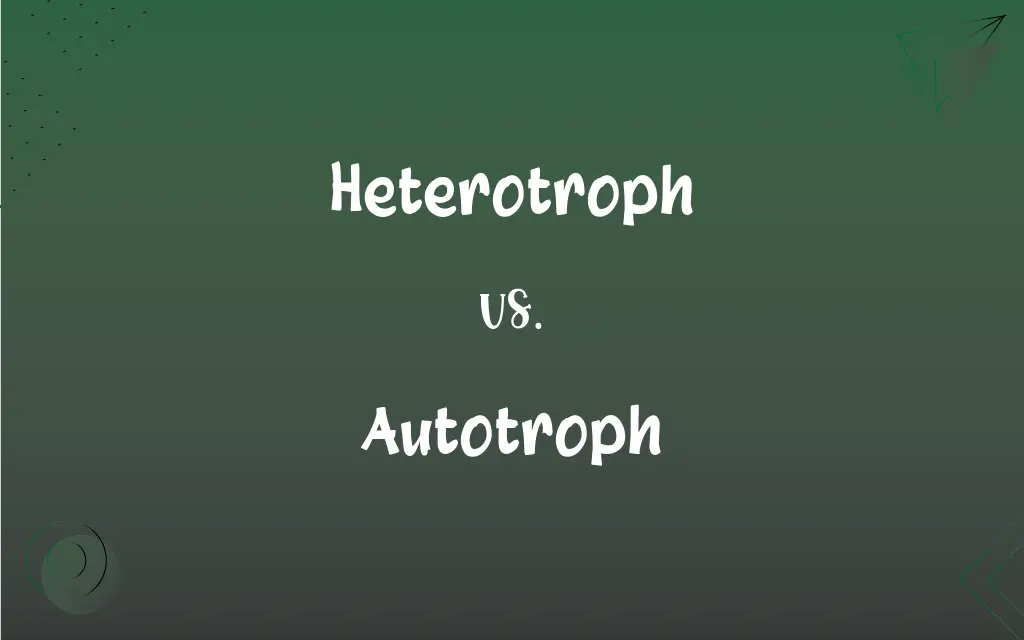Heterotroph vs. Autotroph: What's the Difference?
Edited by Janet White || By Harlon Moss || Updated on October 8, 2023
Heterotrophs obtain energy by consuming other organisms, while autotrophs generate their own energy, usually through photosynthesis or chemosynthesis.

Key Differences
Heterotrophs and autotrophs are two primary categories within the domain of biological organisms based on their nutrient consumption mechanisms. Heterotrophs are dependent on other organisms for their energy and carbon needs. On the contrary, autotrophs have the incredible capability of synthesizing their own food directly from carbon dioxide and an energy source, usually sunlight.
A defining characteristic of heterotrophs lies in their reliance upon other living entities to meet their energy requirements. This contrasts significantly with autotrophs, which, by employing processes such as photosynthesis, translate inorganic substances into organic matter, utilizing energy generally derived from sunlight to do so. This means that, fundamentally, autotrophs can generate their own sustenance.
Consider the rich tapestry of a forest ecosystem. In this environment, autotrophs, typically plants, serve as primary producers, converting sunlight into usable energy and forming the base of the food web. On the other hand, heterotrophs, such as animals and fungi, depend either directly or indirectly on these primary producers, establishing a flow of energy through the ecosystem.
Even within a microcosm, such as a singular ecosystem, the interaction between heterotrophs and autotrophs is evident and essential. Heterotrophs consume autotrophs or other heterotrophs to obtain necessary energy for survival and growth. In stark contrast, autotrophs, including various plants and algae, serve as the primary energy source within these ecosystems, substantiating the energy flow and trophic levels therein.
In a wider scope, the balanced coexistence of autotrophs and heterotrophs shapes our global ecosystem. Autotrophs absorb sunlight and convert it into a format that can be utilized by heterotrophs, establishing a critical balance within the global food web. The biologically rich diversity we observe across our planet’s various ecosystems stems from this fundamental dichotomy, ensuring a dynamic and sustained biological equilibrium.
ADVERTISEMENT
Comparison Chart
Energy Source
Obtains energy from organic substances
Produces energy from inorganic sources like sunlight
Dependency
Depends on other organisms for energy and nutrients
Self-sustaining through photosynthesis
Examples
Animals, fungi
Plants, algae
Role in Food Chain
Consumers
Producers
Energy Conversion
Does not convert light energy to chemical energy
Converts light energy to chemical energy
ADVERTISEMENT
Heterotroph and Autotroph Definitions
Heterotroph
An organism that cannot produce its own food, relying on organic substances for energy.
Humans, as heterotrophs, consume both plants and animals for sustenance.
Autotroph
A living entity that produces complex organic compounds from simple substances present in its surroundings, generally using energy from light or inorganic chemical reactions.
Plants, as autotrophs, convert carbon dioxide and sunlight into glucose.
Heterotroph
A life form that obtains its nutrients and energy from other organisms due to its inability to synthesize them.
A lion, being a heterotroph, hunts other animals to fulfill its energy requirements.
Autotroph
An organism capable of synthesizing its own food from inorganic substances using light or chemical energy.
Algae, an autotroph, utilizes sunlight to create its own food through photosynthesis.
Heterotroph
An organism that necessitates a source of organic carbon, given its inability to fix carbon from inorganic sources.
As a heterotroph, the mouse relies on grains and seeds for nourishment.
Autotroph
An organism that serves as a primary producer in a food chain by creating organic matter from inorganic materials.
In the ocean, phytoplankton, an autotroph, provides the base for many marine food webs.
Heterotroph
A biological entity that occupies various trophic levels within a food web, excluding the first.
A heterotroph, such as a snake, may occupy a higher trophic level by preying on rodents.
Autotroph
A life form that converts physical energy from the sun into stored chemical energy.
Through photosynthesis, an autotroph like the oak tree, turns sunlight into chemical energy stored in glucose.
Heterotroph
An entity within an ecosystem that serves as a consumer, not a producer.
Fungi, acting as heterotrophs, decompose and consume dead organic matter.
Autotroph
An entity that contributes to the first trophic level in ecosystems by producing biochemicals from non-organic compounds.
Cyanobacteria, a type of autotroph, utilize sunlight to convert carbon dioxide and water into glucose.
Heterotroph
An organism that is dependent on complex organic substances for nutrition because it cannot synthesize its own food.
Autotroph
An organism capable of synthesizing its own food from inorganic substances, using light or chemical energy. Green plants, algae, and certain bacteria are autotrophs.
Heterotroph
(ecology) An organism which requires an external supply of energy in the form of food as it cannot synthesize its own.
Autotroph
(ecology) Any organism that can synthesize its food from inorganic substances, using heat or light as a source of energy.
Heterotroph
An organism that depends on complex organic substances for nutrition
FAQs
What is an autotroph?
An autotroph is an organism that creates its own food from inorganic substances, typically using sunlight through photosynthesis.
How do heterotrophs obtain energy?
Heterotrophs obtain energy by consuming other organisms, as they cannot produce their own food.
What is an example of an autotroph?
An example of an autotroph is a green plant, which uses photosynthesis to produce food.
What role do heterotrophs play in the food chain?
Heterotrophs act as consumers in the food chain, obtaining energy by eating other organisms.
Do heterotrophs directly or indirectly depend on autotrophs?
Heterotrophs always depend, either directly or indirectly, on autotrophs for their energy.
What are heterotrophs also referred to as?
Heterotrophs are also referred to as consumers within ecological contexts.
Is there a type of autotroph that does not use sunlight for energy?
Yes, chemotrophic autotrophs generate energy from inorganic substances without utilizing sunlight.
Can heterotrophs perform photosynthesis?
No, heterotrophs cannot perform photosynthesis; they rely on consuming other organisms for energy.
How do autotrophs facilitate biodiversity in ecosystems?
Autotrophs form the base of food chains, supporting various trophic levels and thereby enabling a diverse array of organisms to coexist in ecosystems.
Can animals be autotrophs?
No, animals are typically heterotrophs, relying on consuming other organisms for energy.
What is a common method that autotrophs use to create energy?
Photosynthesis, using sunlight to convert carbon dioxide and water into glucose, is common among autotrophs.
Do heterotrophs contribute to carbon fixation?
No, heterotrophs do not fix carbon; they obtain it by consuming other organisms.
Do autotrophs depend on heterotrophs?
Not for energy, but in ecosystems, heterotrophs and autotrophs often interact and may depend on each other in various ways.
Are fungi heterotrophs or autotrophs?
Fungi are heterotrophs, as they obtain nutrients by absorbing them from other organisms.
What process allows autotrophs to generate their own energy?
Photosynthesis is a common process that allows autotrophs to generate energy, using sunlight, carbon dioxide, and water.
Are bacteria typically heterotrophs or autotrophs?
Bacteria can be both; some species are autotrophic, while others are heterotrophic, depending on their energy and nutrient sources.
Are all plants autotrophs?
While most plants are autotrophs, there are exceptions like parasitic plants that do not perform photosynthesis.
How do autotrophs contribute to the ecosystem?
Autotrophs serve as primary producers, forming the base of the food chain and supporting heterotrophs by providing them with energy.
Do heterotrophs always occupy higher trophic levels than autotrophs?
Generally, yes, since autotrophs are primary producers, while heterotrophs are consumers and typically occupy higher trophic levels.
Can autotrophs consume other organisms?
While autotrophs generate their own energy, some, like carnivorous plants, can also consume organisms.
About Author
Written by
Harlon MossHarlon is a seasoned quality moderator and accomplished content writer for Difference Wiki. An alumnus of the prestigious University of California, he earned his degree in Computer Science. Leveraging his academic background, Harlon brings a meticulous and informed perspective to his work, ensuring content accuracy and excellence.
Edited by
Janet WhiteJanet White has been an esteemed writer and blogger for Difference Wiki. Holding a Master's degree in Science and Medical Journalism from the prestigious Boston University, she has consistently demonstrated her expertise and passion for her field. When she's not immersed in her work, Janet relishes her time exercising, delving into a good book, and cherishing moments with friends and family.































































